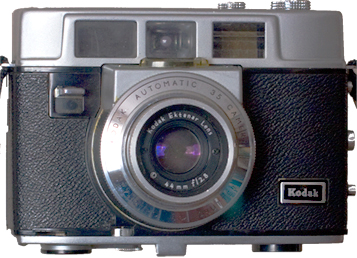
Approx. dates of manufacture: 1959 - 1964
Approx. street value: low
Purchased mostly because I didn't read the Camerapedia webpage all the way through, and I thought this camera came out the year I was born; I'd bought it for vanity (I should have held out for a 35R4). But it was cheap. It's nice. It's got an Ektanar lens, which I believe is actually quite good. What the hell.
Camerapedia also claims that the lenses are somewhat radioactive; I'd have bought one years ago if I'd known that.
Karen Nakamura has some nice photos and a little write-up on her site, Photoethnography. Toward the end, however, she makes this statement:
Let me get something straight: Kodak was never about high quality photography. George Eastman wanted to make photography available for the masses, to put a camera in every hand.
I'm going to take exception to this. The second sentence is true, but the first is not. Yes, Kodak made a lot of Brownies. And they made a lot of non-Brownies that were meant to have mass appeal. However, they gave the world Commercial Ektar view camera lenses, which are highly regarded, as was the large format Master View, the roll-film Medalist, Medalist II and Chevrons, and the Super Six-20. With the exception of the Super Six-20, which is rare, the Medalists and the Chevrons are still highly regarded as users and carry their value. Kodak made some quality 35mm cameras (the Retinas), which came from their German subsidiary. They may be German but they are still Kodaks.
So Kodak could and did make quality stuff when they felt like it. Unfortunately it was a minority of their business.
I can't afford a Medalist or a Medalist II or a Chevron. But I could afford this guy. $9 from Goodwill.
Here's a very simplified chronology of Kodak's American-made 35mm cameras (Retinas are German, and I don't count specialty cameras like the Kodak Stereo). Kodak's first line began just before World War II with the Kodak 35, which went up against the Argus C3 (and lost).
.jpg) In the 1950s, Kodak ended the 35 line and created two new ones. The lower tier was the Pony series, and the upper tier was the Signet series. The Ponys were (in my opinion) really 35mm Brownies. The Signets were meant to compete against the Argus C class of cameras (the lower-middle class of cameras). The last Ponys were introduced in 1957; the last Signet debuted in 1958.
In the 1950s, Kodak ended the 35 line and created two new ones. The lower tier was the Pony series, and the upper tier was the Signet series. The Ponys were (in my opinion) really 35mm Brownies. The Signets were meant to compete against the Argus C class of cameras (the lower-middle class of cameras). The last Ponys were introduced in 1957; the last Signet debuted in 1958.
In 1959, Kodak remodelled the Signet, added an integrated selenium exposure meter and called it the Automatic 35. That's the model I have here.
A second, slightly different, version of the Automatic 35 is called the 35B. The B version does not allow manual exposure, but does add an aperture-Guide Number lock on the lens. A third version is the 35R4, which had a socket to take Magicubes.
Kodak made one other version where they added a spring-driven motor-drive into the camera. You wind it up (much like a movie camera), and every time you trip the shutter, it would advance the film for you. That's an unusual feature—the only other big-name camera I can think of which does this is Canon's Dial-35, which came out several years later. Anyway, Kodak named that camera the "Motormatic 35."
I don't have a Motormatic so I'll mention this here. There are three versions and the only serious difference is how they handle flash. The Motormatic 35 has sockets so you can add the accessory flash-gun. I've heard complaints that the accessory is not ergonomic and disliked.
The next version was the Motormatic 35F, which had an in-camera socket on the top that takes peanut bulbs (AG-5).
The last version is the Motormatic 35R4, whch replaced the AG-5 socket for Magicubes.
The Automatic/Motormatic line ran through 1969. That would be the end of Kodak's American-made 35mm cameras.
Camera manual: Orphan Cameras.com


